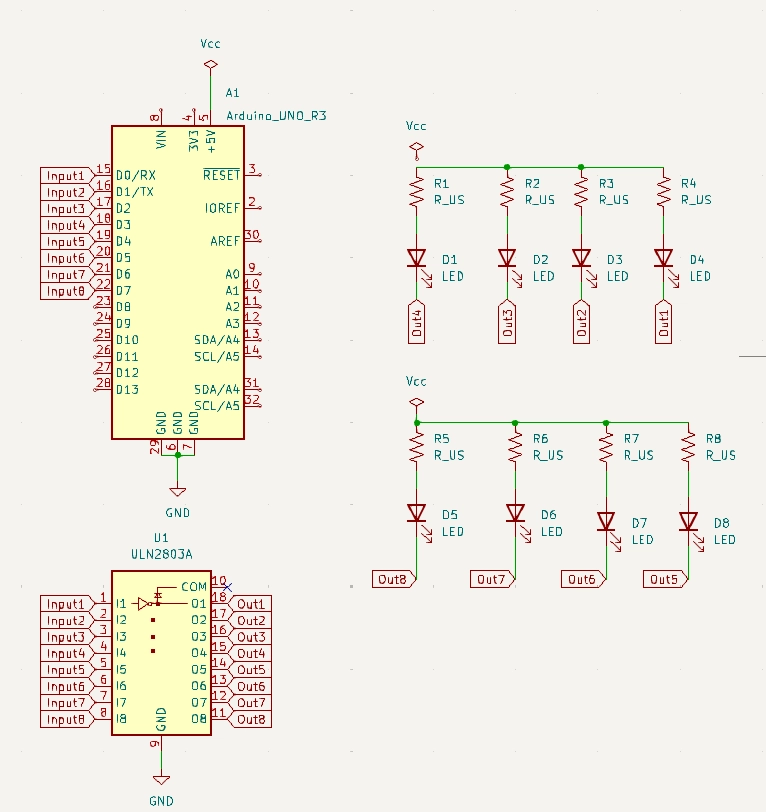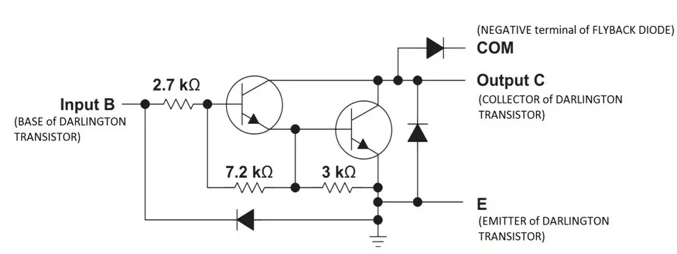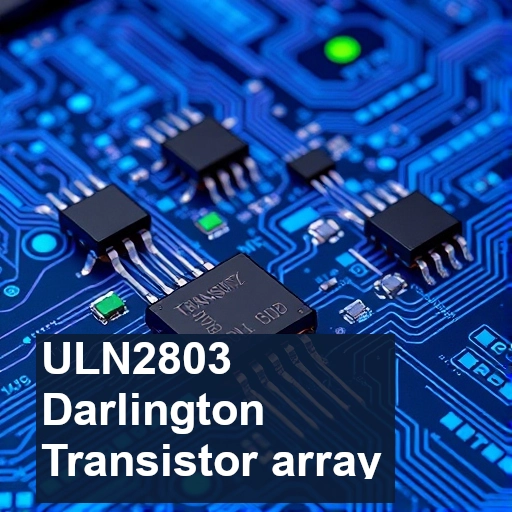The ULN2803 is an integrated circuit (IC) designed to facilitate the control of high-power loads from low-power digital systems. Specifically, it is a high-voltage, high-current Darlington transistor array that allows a microcontroller or logic circuit to interface with larger, high-voltage devices, such as motors, relays, and solenoids, without the need for direct high-current driving.
In this article, we’ll explore the features, applications, internal structure, and key specifications of the ULN2803 and explain why it’s a commonly used component in both industrial and consumer electronics.
Key Features of the ULN2803
- High-Voltage and High-Current Capability: The ULN2803 can handle output voltages up to 50V and current up to 500mA per channel, making it suitable for driving a range of power-hungry devices.
- Darlington Transistor Array: The IC is built using Darlington pairs, which provide high current gain. This allows the IC to act as a buffer between low-power digital circuits and high-power external components, amplifying the current and providing the necessary power handling capability.
- Seven Channels: The ULN2803 contains seven independent channels, each capable of driving a load. These channels are generally used to drive multiple actuators, motors, or relays in parallel, offering flexibility for complex control systems.
- Built-in Freewheeling Diodes: Each output in the ULN2803 has a built-in diode for protection against voltage spikes caused by inductive loads (e.g., motors or relays). These diodes allow the IC to safely handle the back EMF (electromotive force) when switching off inductive loads, a feature that enhances durability and reliability.
- High-Power Drive Capability: The ULN28003 is designed to control loads requiring substantial power, such as 12V or 24V motors, lamps, and solenoids, while drawing only a small amount of current from the driving logic circuit.
- Low Input Current: The input current required to drive the ULN28003 is minimal, typically in the range of microamps. This is beneficial for interfacing with logic-level circuits like microcontrollers or TTL/CMOS logic devices.
Internal Structure and Working Principle
The ULN2803 works by using its internal Darlington transistor pairs to sink current from an external device. When the input to the ULN2803 is driven HIGH by a microcontroller or logic circuit, the corresponding output transistor will turn on, creating a path for the current to flow from the load to ground.
The key to the ULN2803’s operation is that it sinks current instead of sourcing it. This means that the load (such as an LED or relay) must be connected between a positive power supply (e.g., 5V or 12V) and the output pin of the ULN2803, with the output connected to ground.
- Inputs: The IC accepts standard TTL or CMOS logic inputs (typically 2–5V), which are interpreted as high or low logic levels to control each channel.
- Outputs: The output pins can drive a wide variety of loads, and each output is capable of sinking up to 500mA of current.
- Internal Protection: The built-in diodes are used to protect the IC from voltage transients generated when switching off inductive loads, which could otherwise cause damage to the transistors.
When an input signal is applied, it turns on the corresponding Darlington transistor pair inside the IC, allowing current to flow from the output pin to ground. If the load is an inductive device, such as a relay coil or motor, the freewheeling diode provides a path for the current when the transistor turns off, dissipating the stored energy and protecting the transistor.
Applications of the ULN2803
The versatility of the ULN2803 makes it a popular choice in a variety of applications:
- Relay Drivers: One of the most common uses of the ULN2803 is for driving relays. It can interface directly with microcontrollers to switch large electrical currents on and off through mechanical relays, useful in automation, robotics, and home appliance control systems.
- Motor Control: The ULN2803 can be used to control small motors in appliances or robots. It can switch the motor on/off or reverse its direction by controlling the direction of current flow, and it can be used in conjunction with other components like H-bridge circuits for more advanced motor control.
- Solenoid Drivers: Solenoids are used in various applications (like in locks or pneumatic valves). The ULN28003 can efficiently switch these solenoids by providing the necessary current and voltage.
- LED and Lamp Drivers: Large arrays of LEDs or power lamps can be driven by the ULN2803. Since the IC can handle high currents, it is often used in lighting systems where multiple LEDs or bulbs need to be controlled by a microcontroller or logic circuit.
- Industrial Automation: In industrial applications, the ULN2803 can interface between low-voltage control systems (such as PLCs or microcontrollers) and higher-voltage devices such as actuators, motors, and large relays.
- Audio Equipment: The IC can also be found in audio equipment, where it is used to drive components like motors for tape decks or disc drives in response to signals from the logic board.
Circuit connection
Let’s use the ULN2803 to control and toggle LEDs connected to an Arduino. This setup allows the Arduino to interface with the LEDs through the ULN2803, providing the necessary power and protection for efficient control.

Internally it would look something like this

To toggle LEDs in Aduino code
// Define Arduino pins connected to ULN2803 inputs
int ledPins[] = {0,1,2, 3, 4, 5, 6, 7};
void setup() {
// Initialize each LED pin as an output
for (int i = 0; i < 8; i++) {
pinMode(ledPins[i], OUTPUT);
}
}
void loop() {
// Turn LEDs on one by one
for (int i = 0; i < 8; i++) {
digitalWrite(ledPins[i], HIGH); // Turn LED on
delay(500); // Wait for 500ms
}
// Turn LEDs off one by one
for (int i = 0; i < 8; i++) {
digitalWrite(ledPins[i], LOW); // Turn LED off
delay(500); // Wait for 500ms
}Conclusion
The ULN2803 is an invaluable IC for driving high-power loads using low-voltage control signals. Its ability to handle multiple channels, high current, and voltage makes it suitable for a wide variety of applications, from hobbyist projects to industrial control systems.
By providing a simple, cost-effective solution to driving relays, motors, LEDs, and other inductive loads, the ULN2803 continues to be a popular choice in electronics and embedded systems design. Whether you’re a beginner or an experienced engineer, understanding and using the ULN2803 can significantly simplify your circuit designs while providing reliable performance for driving larger components.

